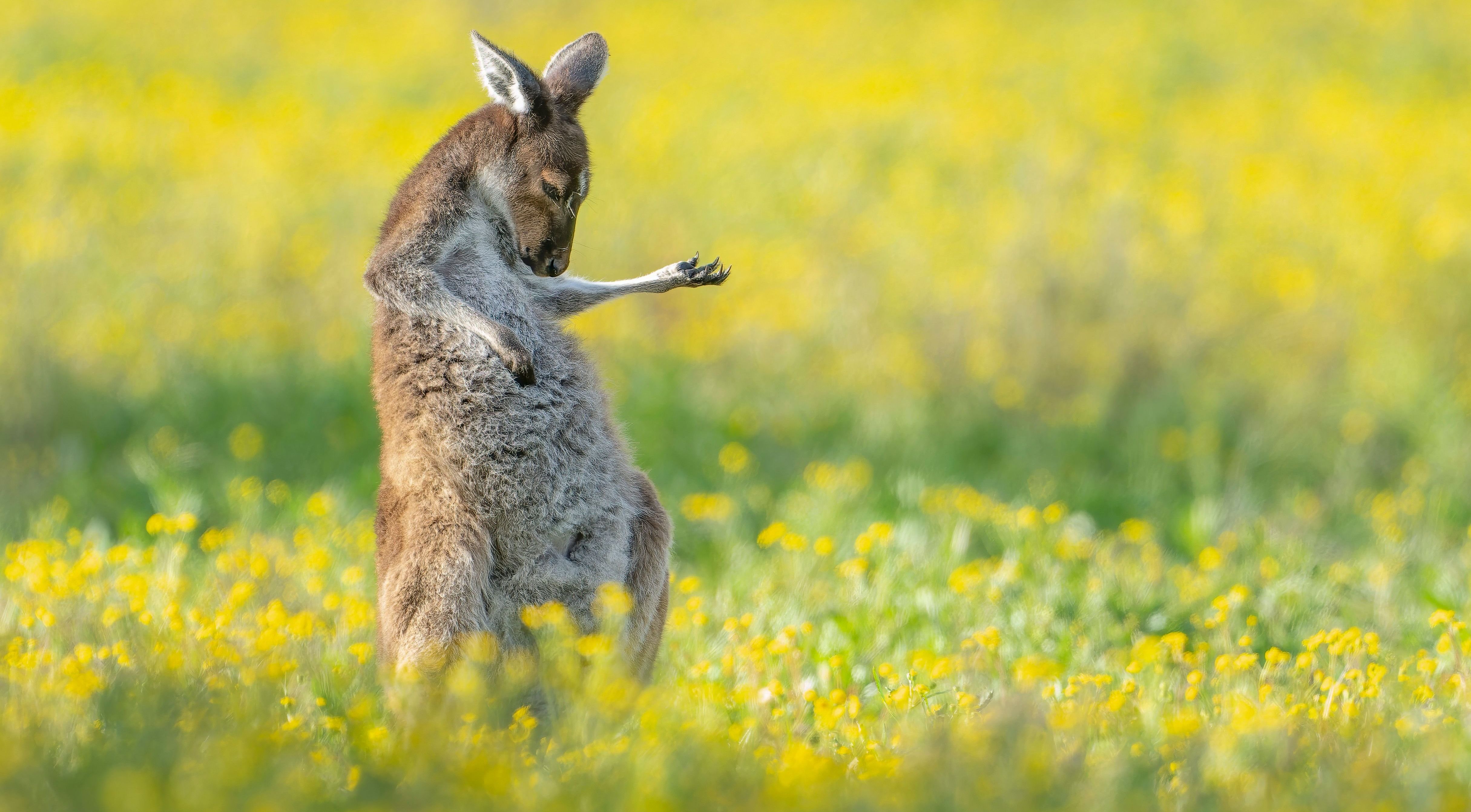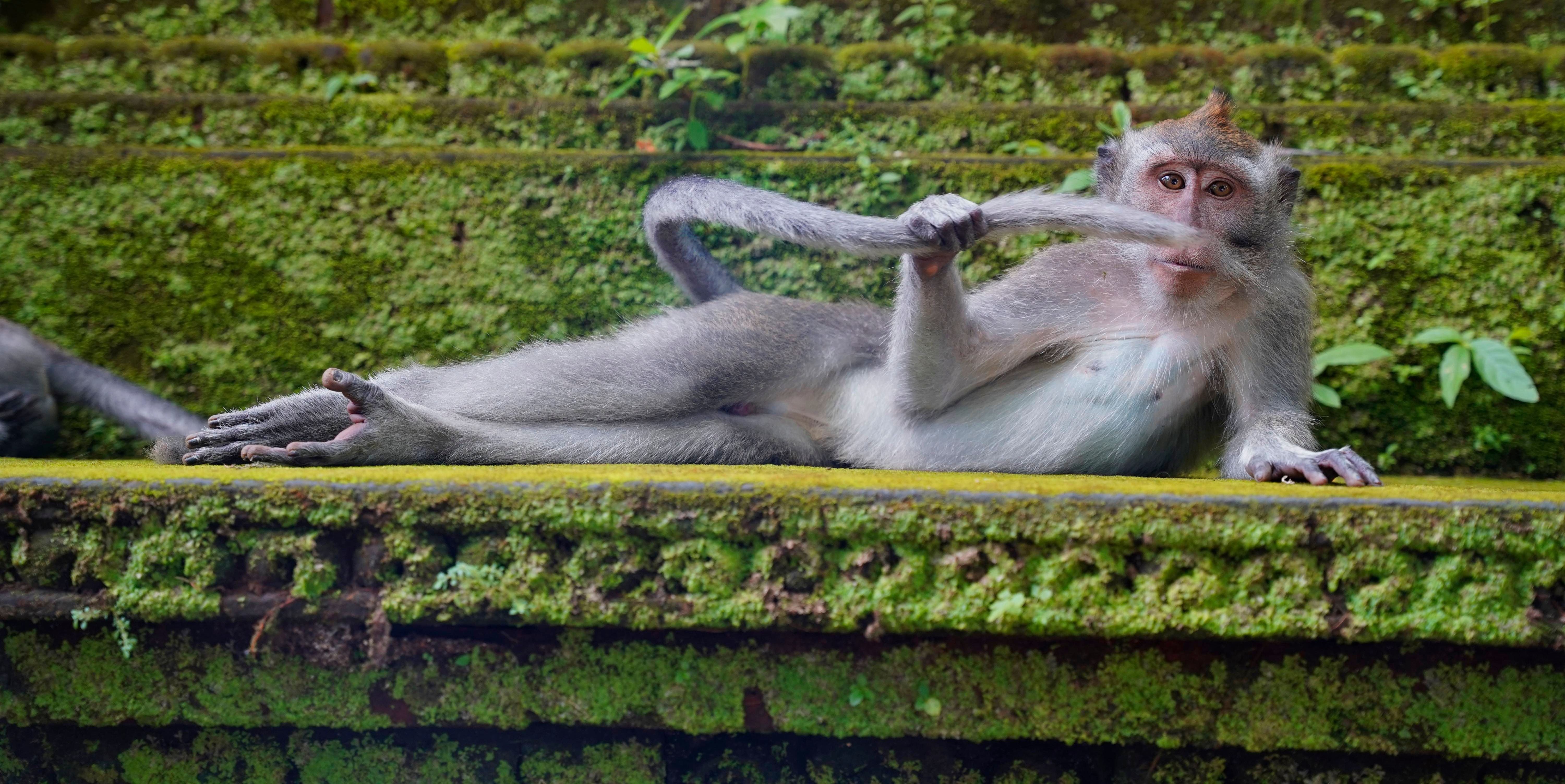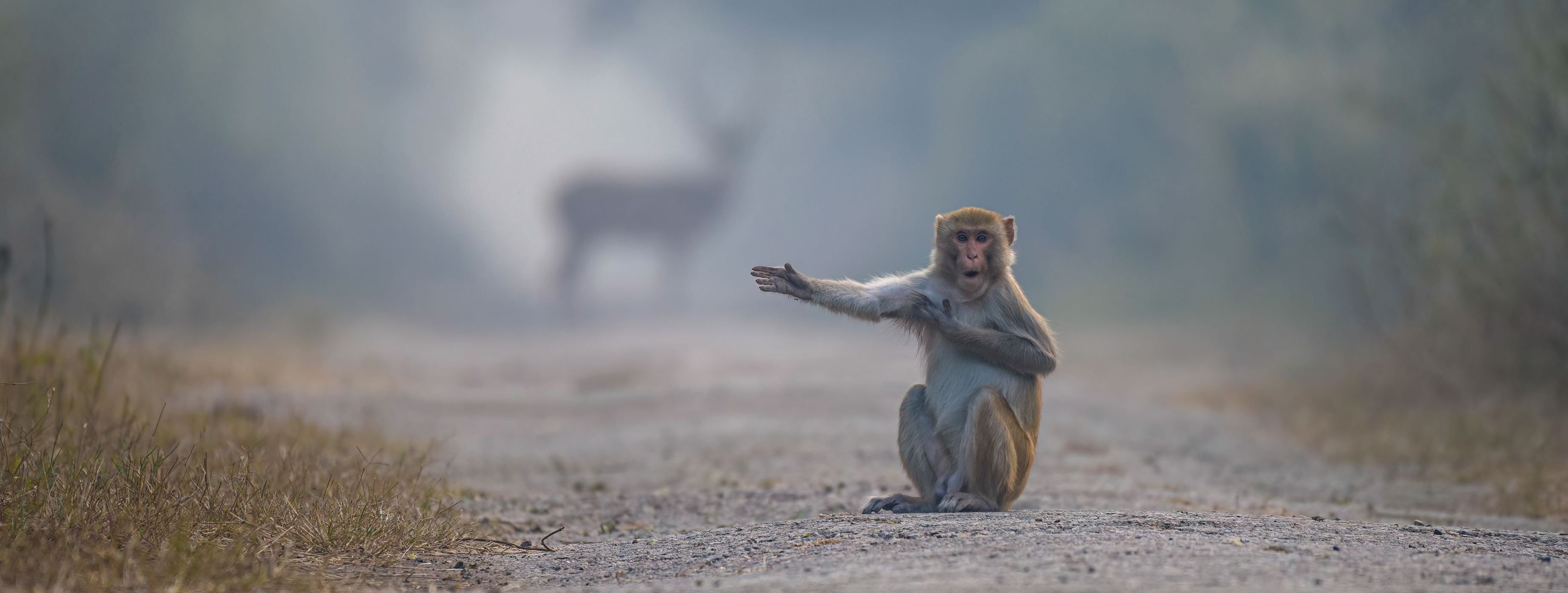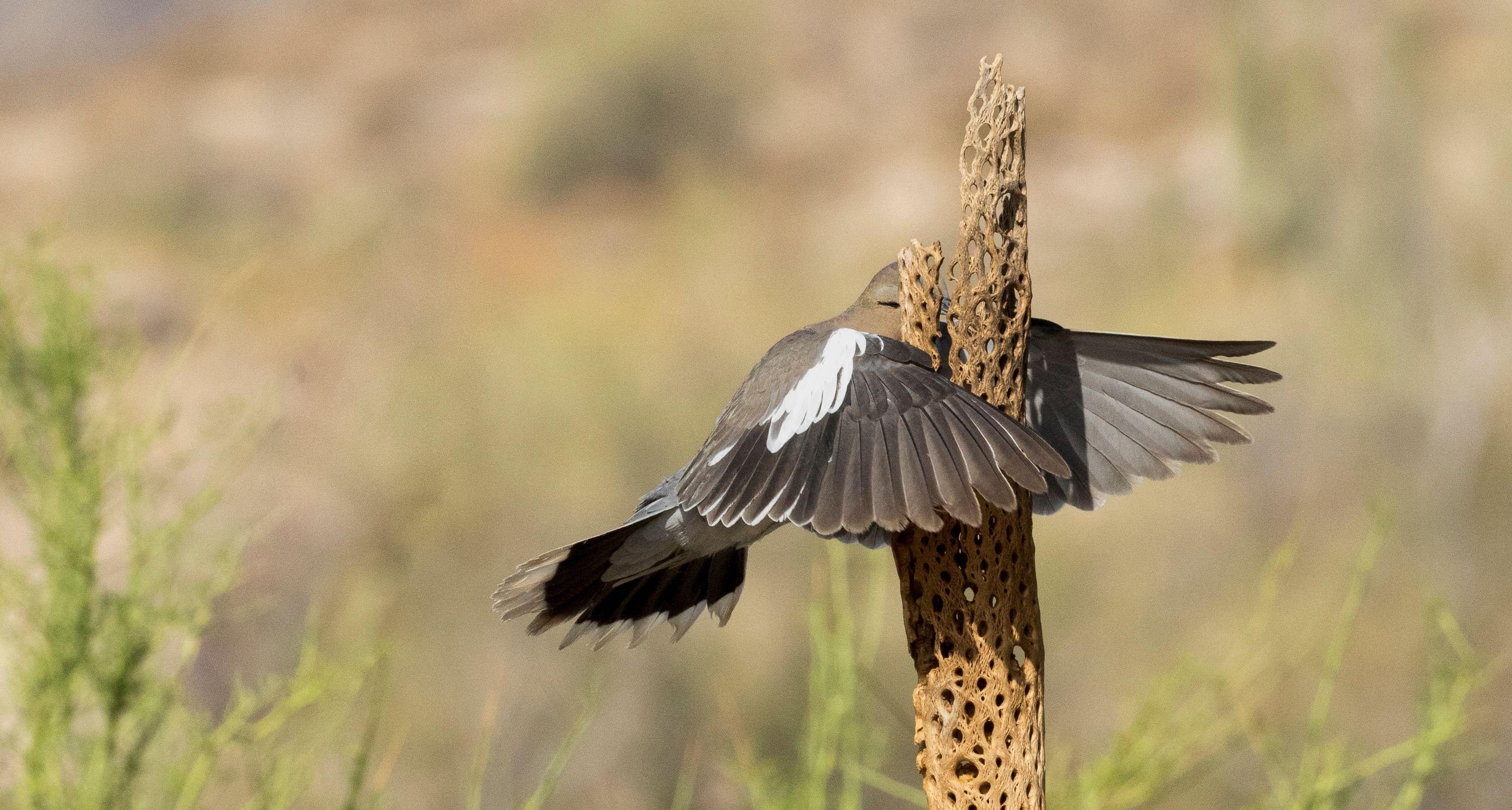14 of the funniest photos from the 2023 Comedy Wildlife Photography Awards
Funny kangaroos, monkeys and more!

The 2023 Comedy Wildlife Photography Awards.
The Comedy Wildlife Photography Awards, known for being one of the most entertaining photography contests, has just wrapped up, and this year’s top prize goes to Jason Moore for his hilarious and brilliantly captured photo of a kangaroo, cheekily named “Air Guitar Roo.” Not only did this fantastic shot win the overall competition, but it also rocked the Creatures of the Land category, too.
Jason's photo stood out among a whopping 5,300 entries submitted by 1,842 photographers from 85 countries. Moore’s photo of the female western grey kangaroo was taken in the outer suburbs of Perth, Australia when Jason visited a field of wildflowers to snap some pics of the many adult kangaroos and joeys playing there.
“The shoot turned out to be a great session, and I am quite fond of several images that I captured,” Moore said in a statement. “Not many people know that kangaroos are normally fairly docile and even a bit boring most of the time if I’m honest. However, when I saw this roo striking the air guitar pose, it immediately brought a smile to my face, and I knew that I had captured something really special."
The Comedy Wildlife Photography Awards was started in 2015 by Paul Joynson-Hicks MBE and Tom Sullam to create a competition focused on the lighter, humorous side of wildlife photography while assuming an essential role in promoting wildlife conservation.
Here are 14 of the big winners.
1. Overall Winner: "Air-Guitar Roo" (grey kangaroo) by Jason Moore, Australia

A kangaroo rocking out.
© Jason Moore/Comedy Wildlife Photography Awards 2023
"On this day, I had been out with my camera photographing some waterfowl at a nearby lake. I had been up at sunrise to take advantage of the 'golden hour' light, but it turned out to be a disappointing morning on the water. After leaving the lake, somewhat dejected, I decided to swing past an area of open bushland, because there are often a 'mob' of Kangaroos feeding and sunning themselves in a field close to the road. ... The morning light was still favorable so I grabbed my camera and headed off to a spot where I could get down to eye level with my subjects. I ended up shooting about 40 or 50 frames of the kangaroos with various content including mum’s, joeys and also some action shots of them bouncing along through the yellow field. The shoot turned out to be a great session, and I am quite fond of several images that I captured. However, when I saw this animal strike this pose it immediately brought a smile to my face and I knew that I had captured something special." — Jason Moore
2. Creatures of the Air Award: "Unexpected Plunge" (heron) Vittorio Ricci, South Africa

A heron takes a dive.
© Vittorio Ricci/Comedy Wildlife Photography Awards 2023
"An unusual end of a perfect moment." — Vittorio Ricci
3. Creatures Under the Water Award: "Otter Ballerina" (smooth-coated otter), Otter Kwek, Singapore

An otter with perfect form.
© Otter Kwek/Comedy Wildlife Photography Awards 2023
"The otter was leaping while attempting to grasp the overhanging leaves, and during an unusual landing, it ended up in the Arabesque pose. I showed this photo to a ballet teacher, and she commented that the otter is a natural but just needs to tuck in its tummy a bit — precisely what a ballet teacher would advise." — Otter Kwek
4. People's Choice Award: "Dispute" (greenfinch), Jacek Stankiewicz, Poland

This greenfinch is very adamant about something.
© Jacek Stankiewicz/Comedy Wildlife Photography Awards 2023
"I caught this scene while watching birds in the Bialowieza Forest. My friends interpret this scene in two ways. One, a young naughty kid is arguing with a parent. Two, a kid is reporting to the parent that their brother did something wrong: 'Look he broke a window!'" — Jacek Stankiewicz
Highly Commended Winners
5. "The Happy Turtle" (swamp turtle), Tzahi Finkelstein, Antarctica

A turtle is about to have a meal.
© Tzahi Finkelstein /Comedy Wildlife Photography Awards 2023
"The swamp turtle is surprised and smiles at the dragonfly resting on its nose." — Tzahi Finkelstein
6. "The Monday Blahs" (great grey owl) John Blumenkamp, USA

This owl is so over it.
© John Blumenkamp /Comedy Wildlife Photography Awards 2023
"While photographing the great gray owl shown in my image, I had been busy working to capture that majestic-looking pose. As the owl preened and then sat still for a short while, it stretched once more and for a quick moment gave the pose shown. As it did, I grinned and thought… now that’s funny!" — John Blumenkamp
7. "One for the Family Album" (gannets) Zoe Ashdown, UK

A proud family of gannets.
© Zoe Ashdown /Comedy Wildlife Photography Awards 2023
"At RSPB Bempton Cliffs, each year between March and October, around half a million seabirds use the chalk cliffs towering above the North Sea to nest and raise a family. Gannets mate for life and they return to the same nest year after year to raise their young. Lying safely at the top of the cliff face, I was able to observe the affection shown between the gannets each time one returned to the nest. They have a greeting ritual, they rub beaks and entwine their necks; it’s how they strengthen their bond. But it’s also a brilliant opportunity to catch them in various poses. I didn’t realize I’d taken this image until I got home, but as soon as I saw it I laughed out loud! They look like proud parents, posing with their baby." — Zoe Ashdown
8. "Don't Look Down" (Atlantic puffin), Brian Matthews, UK

A puffin doing the upside-down Snoopy routine.
© Brain Mattews /Comedy Wildlife Photography Awards 2023
"A puffin does an inverted snoopy impression while watching jelly fish." — Brian Matthews.
9. "Boing" (grey kangaroo) Lara Mathews, Australia

Silly little joey!
© Lara Matews/Comedy Wildlife Photography Awards 2023
"Taken at Westerfolds Park, a beautiful and surprisingly wild pocket of land in the eastern suburbs of Melbourne, famous for its kangaroo population. The mob was enjoying some morning sunshine when this joey decided to get silly and try his hand at boxing." — Lara Mathews
10. "The Rainforest Dandy" (monkey) Delphine Casimir, Bali

A sophisticated monkey.
© Delphine Casimir/Comedy Wildlife Photography Awards 2023
"This picture was taken in the monkey forest in Ubud, Bali, a crazy place where monkeys are king! This forest is special even magical and sacred to the Balinese people. Maybe our dandy is the reincarnation of a divinity?" — Delphine Casimir
11. "Look Right, Bro" (macaque, deer) Pratick Mondal, India

"And on my right, is a deer."
© Pratik Mondal/Comedy Wildlife Photography Awards 2023
12. "That Wasn't Here Yesterday" (white-winged dove) Wendy Kaveney, USA

A white-winged dove disrupted mid-flight.
© Wendy Kaveney/Comedy Wildlife Photography Awards 2023
"A white-winged dove appearing to fly head-on into a cholla cactus skeleton." — Whitney Kaveney
13. "Snowball" (white grouse) Jaques Poulard, Norway

Why is that snowball alive?
© Jaques Poulard/Comedy Wildlife Photography Awards 2023
"The white grouse is coming towards me and looks like a snowball with eyes." — Jaques Poulard
14. "Excuse Me Sir But I Think You're a Bit Too Young to Be Smoking" (grey fox) Dakota Vaccaro, USA

A grey fox that looks like it's enjoying a fine cigar.
© Dakota Vaccaro/Comedy Wildlife Photography Awards 2023
"While I was working deep in the Virginian woods, a family of grey foxes took up residence under the deck of the abandoned cottage next to my work housing. One day, while practicing their hunting skills on bits of moss and branches, one of the kits lunged at a small chunk of wood and started rolling around with his prize. Tired after his hunt, the kit lounged on his belly still holding the wood in his mouth which gave the strong resemblance of a cigar." — Dakota Vaccaro
This article originally appeared two years ago.
- 17 of the funniest photos from the Comedy Pet Photo Awards ›
- 15 of the best entries in the 2022 Comedy Wildlife Photography Awards contest ›
- 18 of the funniest photos from the 2021 Comedy Wildlife Awards ›
- How to take photos that look more like the real you - Upworthy ›
- 18 of the funniest finalists from the 2024 Comedy Wildlife Photography Awards - Upworthy ›
- Upworthy celebrate Subaru with 5 things that made us smile this week 11/29/24 ›
- The 15 funniest winning pictures from the 2024 Comedy Wildlife Photography Awards - Upworthy ›
- 13 winners from the 2021 World Nature Photography Awards - Upworthy ›
- 6 photos of the same girl show how selfies distort what we really look like - Upworthy ›
- Ken Griffey Jr's incredible Masters photos prove his second career is no gimmick - Upworthy ›
- Rescued otter lives in the wild but hits up human for kayak rides - Upworthy ›
- 12 photos of women before and after an orgasm shines a new light on women's sexual wellness - Upworthy ›
- 17 of the funniest finalists in the 2025 Nikon Comedy Wildlife Photography Awards - Upworthy ›

